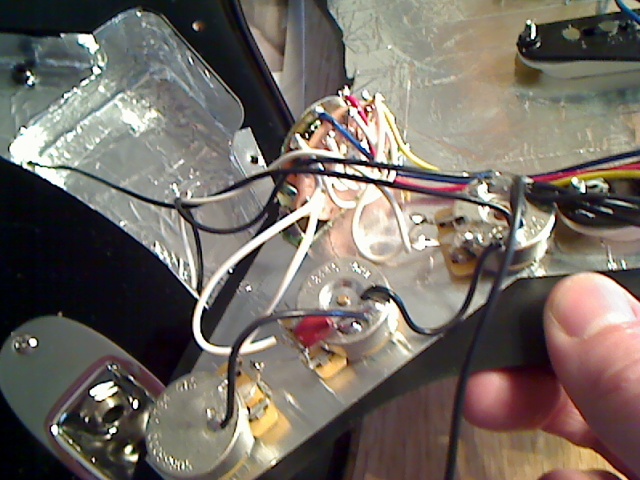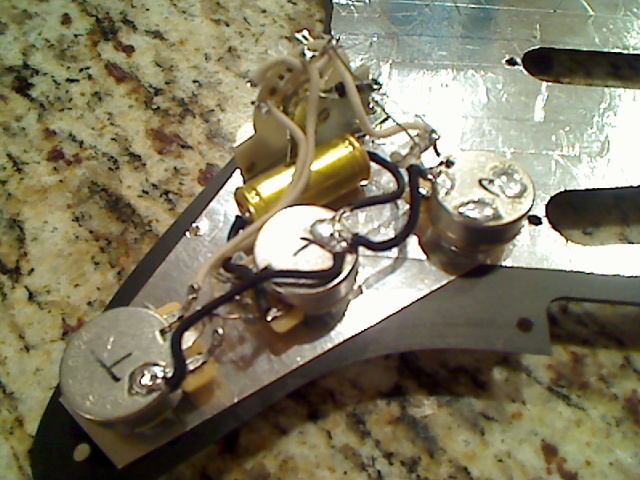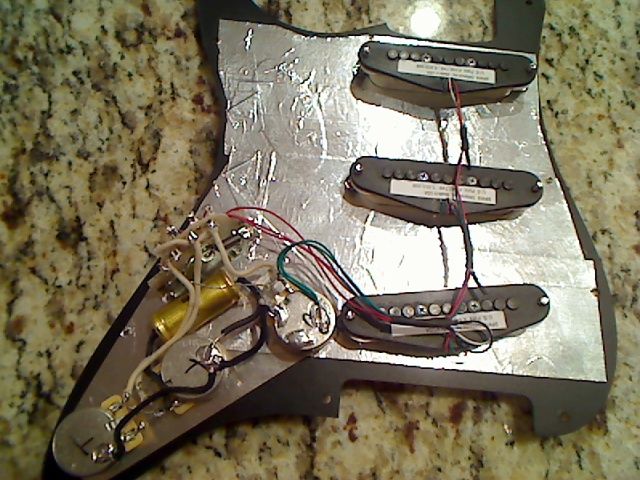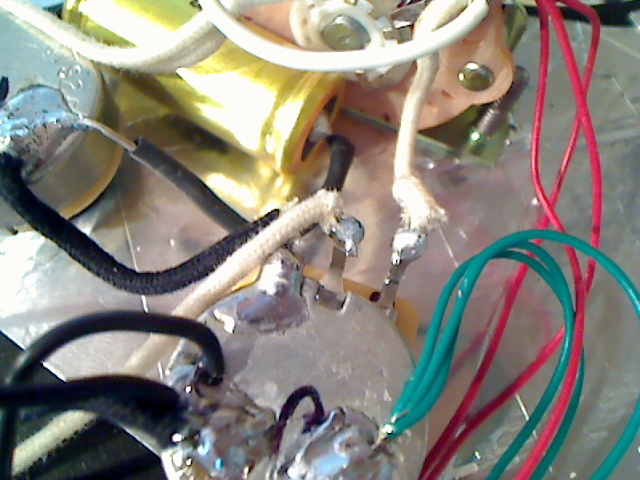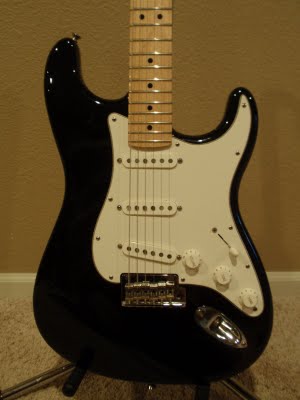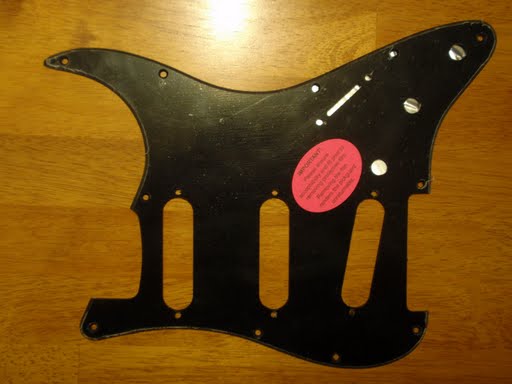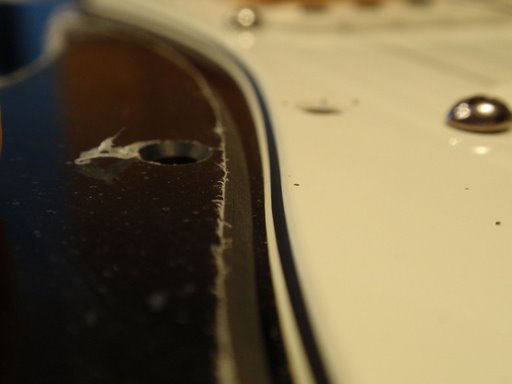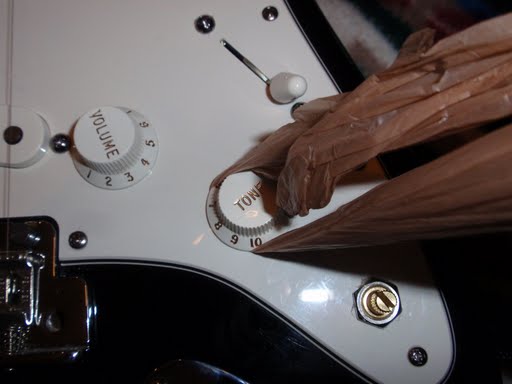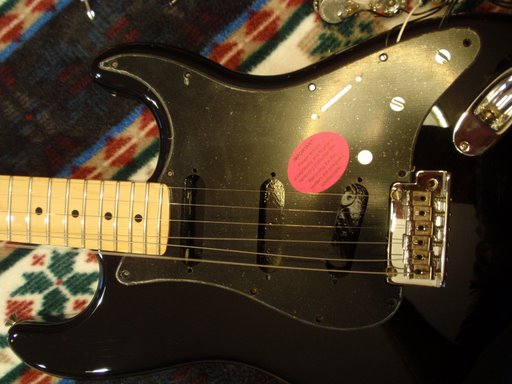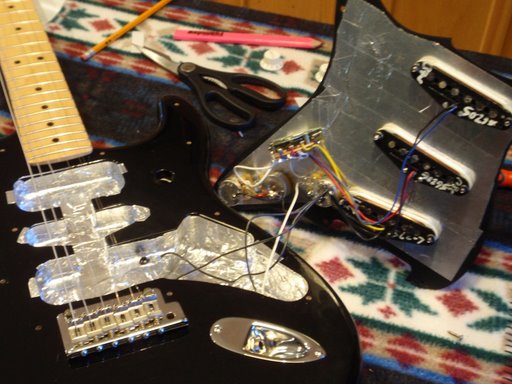I was thinking about this guitar lately because I am wondering if I should attempt to sell it. It's been sitting un-played, in its case, for a very long time now...over a year or more. If you know me personally, you have probably heard the story that goes along with this guitar. It was a great surprise/shock/terror to my wife when I bought it from a Craigslist ad while on a business trip. It's a great party story! ; P
Not very long after I wrote this article on my complete re-do of the electronics, I found an American Standard Stratocaster which is now my regular guitar. I love the Elitist, and realize it rises in value each day I own it...but I still wonder if I should sell it. My wife would love that! It's my "backup guitar" but I haven't needed my backup...ever.
So here it is...nearly a direct reproduction of my 2009 write-up. Pardon the poor photography...it wasn't a focus of this effort, and I was using a little point and shoot with flash. Ugh. These pictures make me cry -- because today they would look much different! But...it's a moment in time, and I cherish them for that!
========== LP Complete Re-Wire [Steps] [Pictures] 05-01-2009, 11:23 PM ==========
Components:
- RS Guitarworks Modern Wiring Kit
- Neck Pickup: Dimarzio Air Norton (Zebra)
- Bridge Pickup: Dimarzio Super Distortion (Zebra)
- Neck Tone Pot controls coil tapping via push/pull
- Bridge Tone Pot controls out of phase select via push/pull
First, let me say that if you are expecting tips from a pro...that's not me! This is my first time to mess with anything inside my guitar. I am posting this so others who are considering tackling the job can see that it is indeed doable, and also hopefully provide some direction and pictures that may help others. I can't say this is perfect, since frankly I have nothing to compare it to. I am proud of my work, and the guitar works....so mission accomplished.
Thanks to those on this forum who gave me lots of threads to research, and especially thanks to hillbilly for setting me up with the RS kit! I am a believer in giving back to people who give to me. I have lurked on this site long enough, and couldn't have done this job without your discussions...so I think it only makes sense that I share back so others can take something away from this experience.
Here is how it went down. Enjoy!
1. Pulled off all four factory pot caps from guitar using the "plastic grocery bag" method.
2. Created a template for wiring using a cardboard packing box top. Pressed the box against the installed pots to indent the cardboard. Drilled out these locations for securing the new pots for wiring.
3. Next, I wired pots up after attaching them to the template. I used a combination of the provided wiring diagram from RS, the diagram from Dimarzio, and some forum posts (to look at pictures). Honestly, it seemed overwhelming at first. But using the resources, I was eventually able to get it to "click" in my brain what all was going on. This is one of the primary reasons I chose to do this myself. I really wanted to learn what was going on under the hood, and wiring your own from scratch is a pretty good way of achieving this goal.
Here is the starting point, and as you can tell, I also measured the pots for resistance values (mostly as a learning experience).
Here is the final wire-up, at least pretty much all I could do outside the guitar. NOTE: I realized after taking this picture that I was missing one more wire, connecting the bottom tone (bridge) to the bottom volume. This was part of the confusing part of taking a diagram for the wiring kit and combining it with another diagram for the phase switch. I was thinking the hot lead that I ran from the switch took the place of the standard bottom lug to bottom lug connection. I was wrong, and didn't realize it until after the build. The result of the missing wire: No tone control for the the bridge. Nothing detrimental...and adding the wire after the fact solved the issue. It was a little challenging to wire it after everything was in place...but careful manipulation of the pointed tip pencil soldering iron yielded successful results without screwing up anything else that was in place.
4. Next, I removed all the existing electronics/pups from the guitar.
Here she is sans wiring:
This is also a good time to poke around.
5. Next, I wired up the 3-way pickup selector switch. I measured what length I needed to wire it to the input jack first, then split the leftover in half for the pot connections. (Thanks for the tip on that, hillbilly!)
Here it is in its home.
6. The next thing I had to do before installing the pots was to drill out holes. The factory pots were smaller than the new pots (standard) so I had to bore the hole out to 3/8". I used the recommendation to use a drill and run it in reverse (from the top side). This worked like a charm. The difference in size is subtle. Here is a pic with two drilled and two factory sized. Can you tell which is which?
Here is all four finished.
7. Next, I wired up and installed the input jack- connecting it to the 3-way switch.
Here is the control cavity...waiting for pots. I used shrink tube for the input jack wire that was exposed to the control cavity. The black tape on the other wire tells me that it's for the Neck volume pot so I didn't wire it backwards since I used the same wire for all three switch runs.
8. Finally, I get to install the pots!
I also made sure the knob ends looked even on the front, using washers to compensate when necessary to control the depth. And, of course, I added my new pointer washers before screwing them in.
10. Now for the pickups. I started with the neck, wired it in, then moved to the bridge. Here is the final control cavity condition. I went ahead and wired both pickups to coil-split with the neck tone push-pull. I then have the bridge wired for reverse phase. NOTE: Also still missing the bridge tone-volume connection. I completed the task..but didn't get the picture of the updated view. This is, however, reflected in the wiring diagram posted below.
11. I took it for a "test drive" before buttoning everything down. I left the strings on, so that if I had any issues to fight I wouldn't waste a new set of strings. The strings weren't a problem, and are actually still on the guitar after the job was complete. All the functions seemed to work as expected, the sound is good and loud, no buzzing, static, etc. (Except it seems I missed the fact that there was no bridge tone control - I was so excited to play with everything else! Ironically, the stock tone controls really didn't seem to do anything, so I guess I was used to hearing little change with adjustment. Now, however, the ENTIRE TONE of the guitar changes with a roll off of the tone! Wow! So that's what those knobs are supposed to do!)
I eventually added the bridge tone-volume connection, and then slapped the new knobs on...and here it is:
Not bad for a half hour of work, eh? Ha! Yeah right! I don't know how long it took me...but defintely several hours from start to finish. I took my time, and went slow and steady. Of course I wasn't able to work on it continously, so it probably drug out longer than it should have.
Here is my wiring diagram:





















